
The Douglas DC-3 is a propeller-driven airliner which had a lasting effect on the airline industry in the 1930s/1940s and World War II. It was developed as a larger, improved 14-bed sleeper version of the Douglas DC-2. It is a low-wing metal monoplane with conventional landing gear, powered by two radial piston engines of 1,000–1,200 hp (750–890 kW). The DC-3 has a cruise speed of 207 mph (333 km/h), a capacity of 21 to 32 passengers or 6,000 lbs (2,700 kg) of cargo, and a range of 1,500 mi (2,400 km), and can operate from short runways.
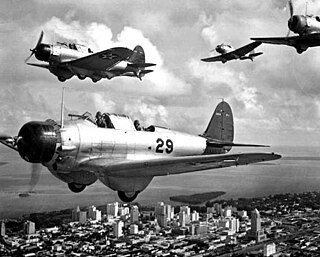
The Northrop BT was an American two-seat, single-engine monoplane dive bomber built by the Northrop Corporation for the United States Navy. At the time, Northrop was a subsidiary of the Douglas Aircraft Company.

The Lisunov Li-2, originally designated PS-84, was a license-built Soviet-version of the Douglas DC-3. It was produced by Factory #84 in Moscow-Khimki and, after evacuation in 1941, at TAPO in Tashkent. The project was directed by aeronautical engineer Boris Pavlovich Lisunov.

The Douglas O-2 was a 1920s American observation aircraft built by the Douglas Aircraft Company.

The Consolidated O-17 Courier was an observation and training aircraft used by the United States National Guard.
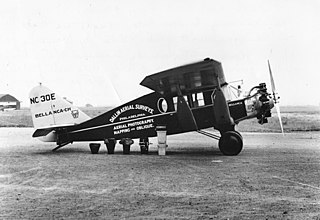
The Bellanca CH-200 Pacemaker was a six-seat, high-wing, single-engine utility aircraft built in the United States in the 1920s. It was a development of the Wright WB-2 that Bellanca had acquired the rights to in 1926 and was the first Bellanca-branded aircraft to gain a type certificate. The CH-200 was used in a number of pioneering long-distance flights and attempts on distance and endurance records.

The Bellanca 31-40 Senior Pacemaker and its derivatives were a family of a six- and eight-seat utility aircraft built in the United States in the late 1930s. They were the final revision of the original late 1920s Wright-Bellanca WB-2 design. The model numbers used by Bellanca in this period reflected the wing area and engine horsepower, each divided by ten. Like their predecessors, these were high-wing braced monoplanes with conventional tailwheel undercarriage.
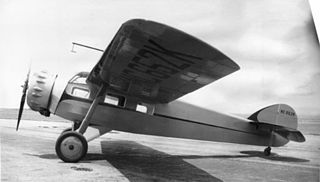
The Cessna Model DC-6 was a 1920s American high-wing four-seat tourer built by the Cessna Aircraft Company. It was used by the United States Army Air Corps as the UC-77/UC-77A.

The Curtiss T-32 Condor II was a 1930s American biplane airliner and bomber aircraft built by the Curtiss Aeroplane and Motor Company. It was used by the United States Army Air Corps as an executive transport.
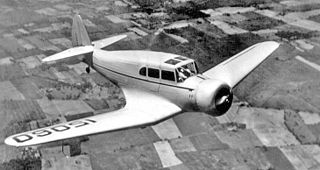
The Fairchild Model 45 was a 1930s American five-seat cabin monoplane aircraft designed and built by Fairchild.
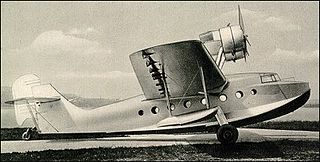
The Macchi M.C.94 was a 1930s Italian commercial flying boat built by Macchi.

The Focke-Wulf A 17 Möwe was an airliner built in Germany in the late 1920s. It was a conventional high-wing cantilever monoplane with fixed tailwheel undercarriage. The aircraft provided fully enclosed seating for up to eight passengers and had a separate, fully enclosed flight deck for the two pilots. Most examples flew with Deutsche Luft Hansa, serving until around 1936. In the early 1930s, two A 17s were used for testing the Junkers Jumo 5 diesel engine.

The SNCASE SE.161 Languedoc was a French four-engined airliner produced by SNCASE (Sud-Est). Developed from the Bloch MB.160 and known in the late 1930s as the (SNCSO) Bloch MB.161, the SE.161 was in service with Air France and the French military after World War II.
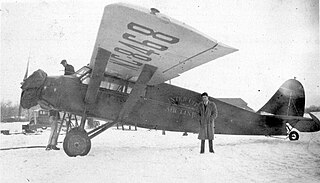
The Stinson Detroiter was a six-seat cabin airliner for passengers or freight designed and built by the Stinson Aircraft Syndicate, later the Stinson Aircraft Corporation. Two distinct designs used the Detroiter name, a biplane and a monoplane.
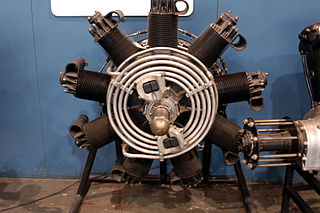
The Packard DR-980 is an American nine-cylinder air-cooled aircraft Diesel engine first certificated in 1930. The engine was unpopular despite its economy and reliability due to the unpleasant nature of its diesel exhaust fumes and considerable vibration when running; approximately 100 were built.
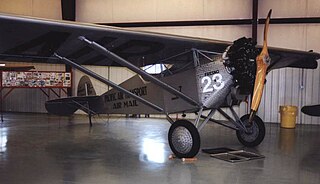
The Ryan M-1 was a mail plane produced in the United States in the 1920s, the first original design built by Ryan. It was a conventional parasol-wing monoplane with two open cockpits in tandem and fixed, tailskid undercarriage.

The Ryan Brougham was a small single-engine airliner produced in the United States in the late 1920s and early 1930s. Its design was reminiscent of the M-1 mailplane first produced by Ryan in 1926, and like it, was a high-wing, strut-braced monoplane of conventional design.

The Verville Air Coach was a four-passenger, high-wing monoplane designed in 1927 by Alfred V. Verville and produced by his company, Verville Aircraft Company. It was a comfortable, good-looking cabin monoplane which sold for $10,500. The plane made its debut at the Detroit Air Show in 1929.

The Curtiss CA-1 was an American five-seat biplane amphibian designed by Frank Courtney and built by Curtiss-Wright at St Louis, Missouri.

The Curtiss/Curtiss-Robertson Model 56 Thrush was a 1929 six passenger high-wing fixed undercarriage single-engine cabin monoplane airliner and utility transport powered by either a Curtiss Challenger or a Wright Whirlwind radial engine and built as an enlargement of the earlier Curtiss Robin. Several were used for record breaking endurance flights by female pilots during the early 1930s including one in which the aircraft stayed aloft for almost ten days.





















